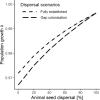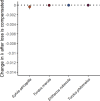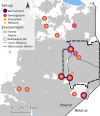Common seed dispersers contribute most to the persistence of a fleshy-fruited tree
- PMID: 36973362
- PMCID: PMC10043030
- DOI: 10.1038/s42003-023-04647-y
Common seed dispersers contribute most to the persistence of a fleshy-fruited tree
Abstract
Mutualistic interactions are by definition beneficial for each contributing partner. However, it is insufficiently understood how mutualistic interactions influence partners throughout their lives. Here, we used animal species-explicit, microhabitat-structured integral projection models to quantify the effect of seed dispersal by 20 animal species on the full life cycle of the tree Frangula alnus in Białowieża Forest, Eastern Poland. Our analysis showed that animal seed dispersal increased population growth by 2.5%. The effectiveness of animals as seed dispersers was strongly related to the interaction frequency but not the quality of seed dispersal. Consequently, the projected population decline due to simulated species extinction was driven by the loss of common rather than rare mutualist species. Our results support the notion that frequently interacting mutualists contribute most to the persistence of the populations of their partners, underscoring the role of common species for ecosystem functioning and nature conservation.
© 2023. The Author(s).
Conflict of interest statement
The authors declare no competing interests.
Figures





Similar articles
-
Historical forest disturbance results in variation in functional resilience of seed dispersal mutualisms.Ecology. 2023 Apr;104(4):e3978. doi: 10.1002/ecy.3978. Epub 2023 Feb 8. Ecology. 2023. PMID: 36692005
-
Forest degradation limits the complementarity and quality of animal seed dispersal.Proc Biol Sci. 2022 May 25;289(1975):20220391. doi: 10.1098/rspb.2022.0391. Epub 2022 May 25. Proc Biol Sci. 2022. PMID: 35611541 Free PMC article.
-
Different megafauna vary in their seed dispersal effectiveness of the megafaunal fruit Platymitra macrocarpa (Annonaceae).PLoS One. 2018 Jul 18;13(7):e0198960. doi: 10.1371/journal.pone.0198960. eCollection 2018. PLoS One. 2018. PMID: 30020929 Free PMC article.
-
The mutualism-antagonism continuum in Neotropical palm-frugivore interactions: from interaction outcomes to ecosystem dynamics.Biol Rev Camb Philos Soc. 2022 Apr;97(2):527-553. doi: 10.1111/brv.12809. Epub 2021 Nov 1. Biol Rev Camb Philos Soc. 2022. PMID: 34725900 Free PMC article. Review.
-
Uniting niche differentiation and dispersal limitation predicts tropical forest succession.Trends Ecol Evol. 2021 Aug;36(8):700-708. doi: 10.1016/j.tree.2021.04.001. Epub 2021 May 7. Trends Ecol Evol. 2021. PMID: 33966918 Review.
Cited by
-
Downscaling mutualistic networks from species to individuals reveals consistent interaction niches and roles within plant populations.Proc Natl Acad Sci U S A. 2025 Feb 18;122(7):e2402342122. doi: 10.1073/pnas.2402342122. Epub 2025 Feb 12. Proc Natl Acad Sci U S A. 2025. PMID: 39937855 Free PMC article.
-
Tracking individual seed fate confirms mainly antagonistic interactions between rodents and European beech.Biol Lett. 2025 Jan;21(1):20240586. doi: 10.1098/rsbl.2024.0586. Epub 2025 Jan 22. Biol Lett. 2025. PMID: 39837493 Free PMC article.
References
-
- Harvey E, Gounand I, Ward CL, Altermatt F. Bridging ecology and conservation: from ecological networks to ecosystem function. J. Appl. Ecol. 2017;54:371–379. doi: 10.1111/1365-2664.12769. - DOI
-
- Vázquez DP, Morris WF, Jordano P. Interaction frequency as a surrogate for the total effect of animal mutualists on plants. Ecol. Lett. 2005;8:1088–1094. doi: 10.1111/j.1461-0248.2005.00810.x. - DOI
-
- Winfree, R. in Unsolved Problems in Ecology 338–354 (Princeton University Press, 2020).
Publication types
MeSH terms
LinkOut - more resources
Full Text Sources

